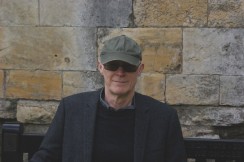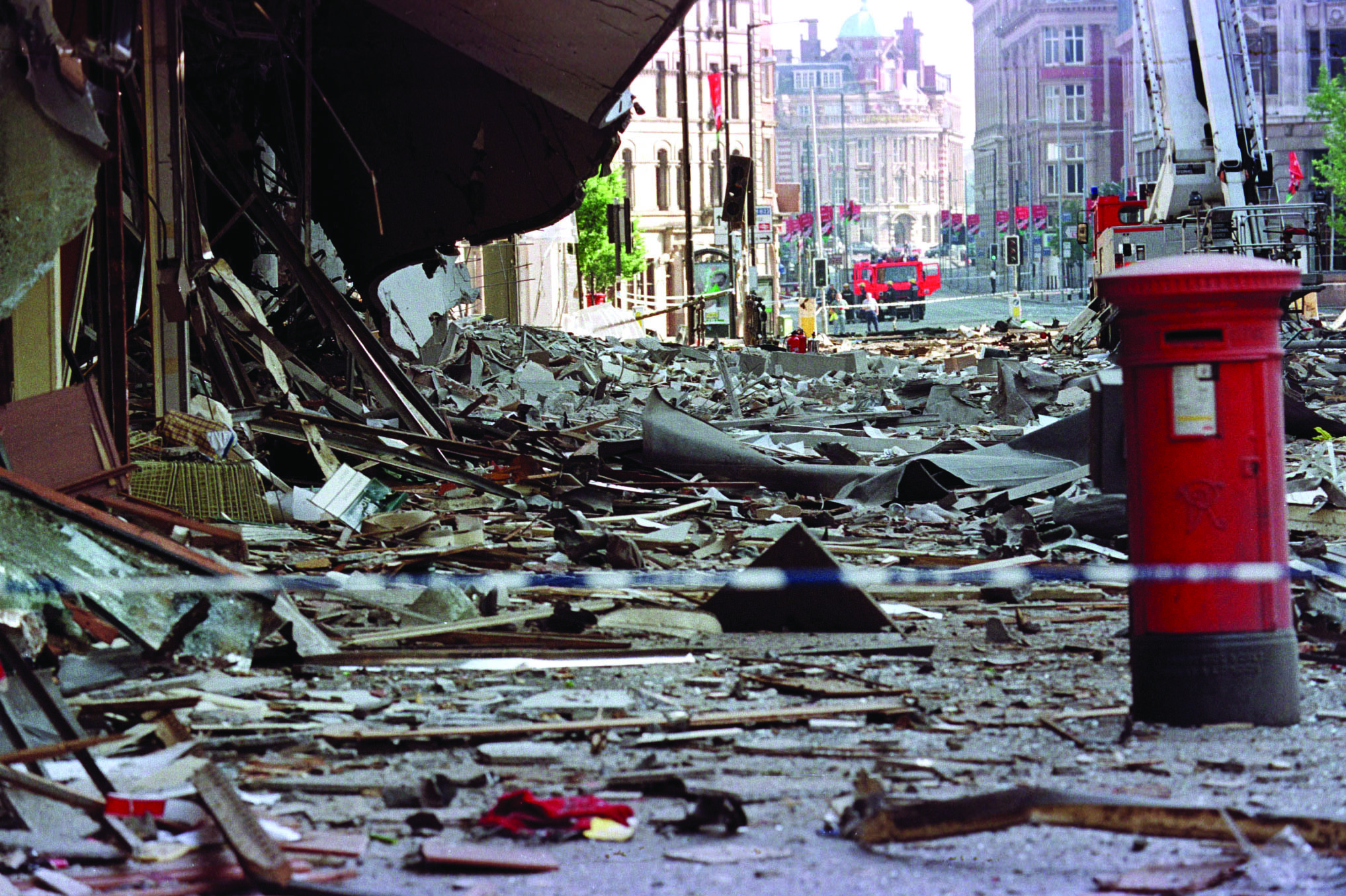Big bang theories
Some say the 1996 IRA bomb set Manchester on the road to recovery. Others say that's an insult to the city
For Mancunians, 15 June 1996 means more than Paul Gascoigne’s famous goal against Scotland in Euro 96. The day has attained an almost mythical status, not just in the city itself but as the key chapter in the wider narrative of how regional British cities came to be regenerated and revitalised in the New Labour years.
An oft-cited saying goes along the lines of “the IRA did Manchester a massive favour” – that the 3,300lb explosive cleared an unfavoured chunk of city centre real estate and triggered a windfall of redevelopment cash. Senior figures from rival cities have said it. The comedian Jason Manford had a good line: “Nobody died, and we got a big new Next.” True, but 212 people were injured. Damage to insured property was calculated at £700 million – £1.2 billion at today’s values. Of the 400 businesses affected, 40 per cent never recovered.
Phil Griffin, the Manchester-based writer and curator, wrote recently: “Talk of the bombers doing Manchester a favour is as barmy now as it was 20 years ago. They smashed the city. You could argue that such extensive reconstruction put Manchester at an advantage over other post-industrial cities, but such an argument overlooks the peril that 80,000 innocent people were placed in that morning, and the clean-up that took three years to complete.”
Within a week of the bomb Michael Heseltine had been dispatched north and a taskforce established. Heseltine was then deputy prime minister but 15 years previously had been the architect of urban development schemes that had brought a previous wave of regeneration to the city.
A family fun day was held in Albert Square, leisure entrepreneurs were encouraged to come up with new ideas and events. Jon Drape, managing director of Parklife organiser Ground Control Productions, was managing the Haçienda and Dry Bar at the time. He says: “That day was the first and only Saturday night that the Haçienda didn’t open in the 15 years it ran for. The city wanted events, they wanted to send out the message people should be coming into Manchester.”
In fact the Haçienda closed for a while in 1991 over security issues but the point remains.
Mike Butterworth, the Manchester writer who lived in Cromford Court flats within the Arndale complex, reckons the bomb did indeed play a part in the city’s rebirth. He says: “I believe Manchester’s buoyancy has been facilitated by three things — the beacon effect of Factory Records and the Haçienda, the innovative regenerative policy of the council to mix public and private money, and the kick up the pants delivered unintentionally by the IRA.”

The city did right by those whose homes were damaged, says Butterworth. “I personally felt cared for, looked after and fairly compensated. The council kicked in very quickly – none of us were left sleeping on park benches. The support continued afterwards. We didn’t have to do anything except attend meetings to register ourselves for whatever stage of assistance came next.”
Commercially, it was a different story. The Corn Exchange, as it was, had gone forever. Butterworth says: “I think the then owners saw the bomb as a way of taking the building upmarket. They took it away from the flea market image it had when we ran a bookshop there and there was no consultation. We were all forced out, and upmarket boutiques and cafés replaced us.”
Regeneration can go wrong. The subsequent re-pitching of the Corn Exchange as The Triangle didn’t work. Its 2015 relaunch, bombarding the city with modish food brands in a way that simply couldn’t be done in the late 1990s, looks to have finally done the trick. But still, a part of the city’s soul has gone, says Griffin. “The Corn Exchange should be offering Manchester that Brussels-type flea market experience. There’s only the Northern Quarter with that independence in Manchester now.”
What of the new developments in the immediate area? Urbis, always admired as a building, has now found its role as the National Football Museum. The New Cathedral Street retail pitch more or less meets the objective of linking St Anns Church to Manchester Cathedral. The Arndale’s new wing commands Manchester’s highest retail rents. But Exchange Square, that non-square slice of land between the Corn Exchange and Selfridges, is a bone of contention.
Star landscape architect Martha Schwartz designed the space – nominally at least. This is one of those projects – not uncommon in regional cities – where architectural vision meets harsh economic reality and loses heavily. It’s all about deliverability. At a Landscapes of Identity symposium last month, part of the Manchester Histories Festival, Schwartz declared herself unable to even look at Exchange Square.
It’s a similar tale in Piccadilly Gardens, away from the impact zone but still part of the masterplan for redevelopment. For all the opprobrium heaped on the Tadao Ando-designed pavilion and wall, it’s the quality of the materials and management that have been lacking.
In Griffin’s view, the new buildings and public realm have been a mixed bag, but with some inevitability. “The longer businesses and places were out of action, the more insurers had to pay. So there was pressure to act quickly. Really, it was inevitable that some things would be good and some not so good.”
So how much of Manchester’s renaissance has been down to 1996 and all that? The city won’t be dragged into nostalgic reverie, politely declining an interview request and issuing a statement bookended by these two paragraphs: “We do not forget the events of that day or seek to downplay them. We recognise and respect the courage shown by the emergency services and Mancunians and the resilient spirit shown by the city. But nor do we choose to dwell on the events of 15 June 1996 every five years.
The city’s line has been consistent: its resurgence began before the bomb
“Rather than harking back to one moment in the city’s eventful history, we prefer as a council to look forward. Northern Ireland, in whose politics the bombing had its roots, has thankfully moved on. The world has moved on. Manchester has moved on.”
The city’s line has been consistent down the years: its resurgence began in the early 1990s, before the bomb, with the confidence provided by the Olympic and Commonwealth bids acting as its springboard. By 1996, the Manchester Arena and the “medal factory” Velodrome were already built. The Gay Village and universities were thriving.
All true. Manchester in time secured £83 million of government and European money, including £30 million from the Millennium Commission. But other cities had Millennium money too and not all of them used it well. A further £500 million private sector investment was levered into Manchester between 1996 and 1999.
Manchester went from strength to strength as the city and property developers fell for each other in a big way – Urban Splash for trendy flats, Bruntwood for revamping old offices, Allied London for blue chip business space. Manchester’s relationship with property has been mutually beneficial, and key to the city being widely regarded as the most business-friendly in the UK.
In 1996 there were already intertwined relationships between emerging property developers and those who ran music venues, labels and bars. Many had feet in both camps. The bomb and a city prepared to listen gave them the confidence to think “we can be a part of this”. As Drape says: “After the bomb, I remember us getting together with other people involved in bars and clubs right away.”
Drape was part of a loose coalition of rabble-rousers who reacted furiously to tourism body Marketing Manchester’s “We’re Up and Going” campaign, launched to great fanfare at the Bridgewater Hall (another signifier of renaissance – started in 1993, opened in September 1996). Known as the McEnroe Group – “You cannot be serious!” – with village elders including Tony Wilson and Simply Red manager Eliot Rashman, it offered alternatives.
From this group and the spirit it engendered, creative people began to permeate the corridors of power. Colin Sinclair, who ran the Boardwalk and managed the band James, ended up running Midas, the city’s inward investment agency. Marketing Manchester had an incredible run of bidding for major sporting and cultural events. That body was chaired for a time by Nick Johnson, a key McEnroe Group agitator and ex-deputy chief executive of Urban Splash, now the man behind the highly regarded Altrincham Market.
During this time, the Manchester International Festival came to signify the city’s desire for acceptance among Europe’s grown-up cities – to be more than nightclubs, football and Corrie. The debates can rage about architecture, transport and the city’s soul, but all agree on one thing – Manchester’s a very different place now. It’s a city more assured of its ability to compete on the grand stage, to attract people and investment.
Butterworth says: “A lot has been made right. It’s become an amazing place, starting from a semi-derelict commuter city that was dead from the ankles up. This was how it was in the early 1980s, before the Hacienda was opened and the council began its redevelopment schemes.”

Leave a reply
Your email address will not be published.